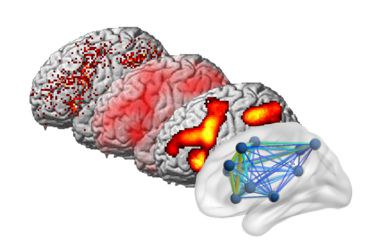Brain Scan for Individual Prognosis
Magnetic resonance imaging (MRI) provides sectional images of the brain. Doctors use them in everyday medicine to detect pathological changes. Researchers use a modified method – functional MRI (fMRI) – to make the brain areas, which are active at the time the image is taken, visible. The team, led by Prof. Simon Eickhoff, director at the Jülich Institute of Neuroscience and Medicine, evaluates MRI and fMRI brain scans of often hundreds of people in a very special way: the team trains computers to read activity patterns in functional networks of the brain from the image data. That way, Simon Eickhoff would one day like to be able to assess to what extent the activity patterns of people suffering from depression, schizophrenia or Parkinson’s disease are individually altered. He hopes that this information will then make it possible to predict the further course of the disease in the person affected. Our author Frank Frick spoke with the brain researcher.
To what extent could people with mental or neurological diseases benefit from your research in the future?

Let us take depression as an example. Up to 30 per cent of all people who have recovered from severe depression suffer from it again later. In the age of the Internet, most of those affected know this. For many of them, it is very important to know whether they are among those who will suffer a relapse. At the moment, however, doctors cannot really predict this because they can only assess the current situation. We think that our methods and future developments have the potential to give an individual forecast. This means that the individual probability of a relapse could be quantified.
Another example is Parkinson’s disease. Many patients want to know if they will develop dementia. This is of course a question that also interests relatives. Here, too, I see a very important field of application for future prognostic methods.
How is that supposed to work?
The idea can be explained by the example of two patients. Their medical condition appears to be the same. The functional networks in the brain, however, show characteristic differences that can be made visible from MRI images using new methods of machine learning. Let us assume that in one of the two patients, these networks are affected more severely than doctors would expect from the symptoms, while the other patient is affected much less. Then it becomes pretty clear: one must be more concerned that the condition of the patient with the severely defective functional networks will deteriorate significantly within a year. Our concept is therefore based on the assumption that the image data contain information about damage to the brain – damage that only later becomes externally apparent.
I would like to stress that we are still a long way from clinical application of our methods. However, a large share of the tools that we will need for this – in particular, the approaches for characterising functional networks in the brain and for individual predictions – are already working promisingly.

But there are certainly also people who suffer from depression or Parkinson’s who do not want to know their future ...
Yes. And I am an advocate of the right not to know. But on the other hand, I have learned in my clinical work that “What happens next” is the most important and urgent question for most patients and their relatives, as many psychiatric and neurological diseases occur in phases, such as schizophrenia, or progress continuously, such as dementia.
Could the results of image data analysis also change the treatment of such mental and neurological diseases in the future?
I would very much hope so; if so, certainly not in the next few years. The problem so far is: not every drug helps every patient; that means that, for example, not every depressive person benefits from every antidepressant. The situation is similar with schizophrenia. In case of doubt, if treatment is not successful, something new must be tried out – a very unsatisfactory situation. Our goal, therefore, would be to find signatures in the brain that tell us that we should best treat this patient with drug A and not with drug B. Such approaches have a very high potential, but we are still at the beginning here.
You use machine learning methods to evaluate brain scan image data and make prognoses. There is criticism and concern about the use of artificial intelligence and the possible misuse of patient data. What is your position on that?
These fears must by all means be taken seriously. In healthcare systems, especially in the US, insurance companies are already considering evaluating brain scan data. They want to calculate the risk of disease of individuals and we must be very optimistic so as not to fear that this will happen with the aim of excluding these cases in advance. Or think of the “Social Credit System” that is already being tested in China: the state assesses the behaviour of citizens with the help of artificial intelligence. However, the consequence cannot be that we in Germany, and especially here in Jülich, stop research on these topics and leave the further development to others. We have the opportunity to shape the development in the health sector and to make the possibilities and limitations of technologies transparent. In addition, the research centres of the Helmholtz Association are committed to society: we do not conduct research to maximise profits, but to find answers to major social challenges. We should seize this opportunity.
Frank Frick
